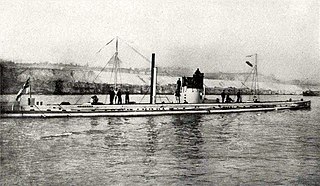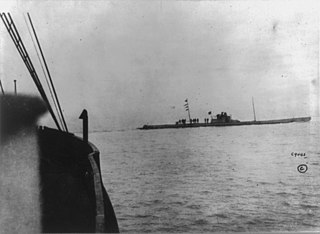SM U-32 was a German Type U 31 U-boat of the Imperial German Navy.

SM U-35 was a German U 31-class U-boat which operated in the Mediterranean Sea during World War I. It ended up being the most successful U-boat participating in the war, sinking 220 merchant ships for a total of 505,121 gross register tons (GRT).

SM U-9 was a German Type U 9 U-boat. She was one of 329 submarines serving in the Imperial German Navy, and engaged in commerce raiding (Handelskrieg) during World War I.
SM U-68 was a Type U 66 submarine or U-boat for the German Imperial Navy during the First World War. She had been laid down in December 1913 as U-9 of the U-7 class for the Austro-Hungarian Navy but was sold to Germany, along with the others in her class, in November 1914. Under German control, the class became known as the U 66 type and the boats were renumbered; U-9 became U-68, and was redesigned and reconstructed to German specifications. She was launched in June 1915 and commissioned in August.

SM U-38 was a German Type U 31 U-boat which operated in the Mediterranean Sea during World War I. It ended up being the third most successful U-boat participating in the war, sinking 134 merchant ships sunk for a total of 287,811 GRT.
SM U-69 was a Type U 66 submarine or U-boat for the German Imperial Navy during the First World War. She had been laid down in February 1914 as U-10 the fourth boat of the U-7 class for the Austro-Hungarian Navy but was sold to Germany, along with the others in her class, in November 1914.
SM U-67 was a Type U 66 submarine or U-boat for the German Imperial Navy during the First World War. She had been laid down in November 1913 as U-8 the second boat of the U-7 class for the Austro-Hungarian Navy but was sold to Germany, along with the others in her class, in November 1914.
SM UB-39 was a German Type UB II submarine or U-boat in the German Imperial Navy during World War I.
SM UC-20 was a German Type UC II minelaying submarine or U-boat in the German Imperial Navy during World War I. The U-boat was ordered on 29 August 1915 and was launched on 1 April 1916. She was commissioned into the German Imperial Navy on 7 September 1916 as SM UC-20. In 13 patrols UC-20 was credited with sinking 21 ships, either by torpedo or by mines laid. UC-20 was surrendered on 16 January 1919 and broken up at Preston in 1919–20.

SM UC-21 was a German Type UC II minelaying submarine or U-boat in the German Imperial Navy during World War I. The U-boat was ordered on 29 August 1915 and was launched on 1 April 1916. She was commissioned into the German Imperial Navy on 12 September 1916 as SM UC-21.
SM UC-26 was a German Type UC II minelaying submarine or U-boat in the German Imperial Navy during World War I. The U-boat was ordered on 29 August 1915 and was launched on 22 June 1916. She was commissioned into the German Imperial Navy on 18 July 1916 as SM UC-26. In nine patrols UC-26 was credited with sinking 39 ships, either by torpedo or by mines laid. UC-26 was rammed and sunk by HMS Milne off Calais on 8 May 1917.
SM UC-33 was a German Type UC II minelaying submarine or U-boat in the German Imperial Navy during World War I. The U-boat was ordered on 29 August 1915 and was launched on 26 August 1916. She was commissioned into the German Imperial Navy on 25 September 1916 as SM UC-33. In seven patrols UC-33 was credited with sinking 36 ships, either by torpedo or by mines laid. UC-33 was shelled and then rammed by patrol boat PC61 captained by Frank Worsley at position 51°55′N6°14′W in St. George's Channel on 26 September 1917.
SM UC-40 was a German Type UC II minelaying submarine or U-boat in the German Imperial Navy during World War I. The U-boat was ordered on 20 November 1915 and was launched on 5 September 1916. She was commissioned into the German Imperial Navy on 1 October 1916 as SM UC-40. In 17 patrols UC-40 was credited with sinking 30 ships, either by torpedo or by mines laid. UC-40 was being taken to surrender but foundered in the North Sea en route on 21 January 1919.
SM UC-45 was a German Type UC II minelaying submarine or U-boat in the German Imperial Navy during World War I. The U-boat was ordered on 20 November 1915 and was launched on 20 October 1916. She was commissioned into the German Imperial Navy on 18 November 1916 as SM UC-45. In five patrols UC-45 was credited with sinking 12 ships, either by torpedo or by mines laid. UC-45 sank in a diving accident on 17 September 1917 in the North Sea. The German salvage vessel Vulkan raised the wreck and UC-45 re-entered service on 24 October 1918. She was surrendered on 24 November 1918 and broken up at Preston in 1919–20.
SM UC-60 was a German Type UC II minelaying submarine or U-boat in the German Imperial Navy during World War I. The U-boat was ordered on 12 January 1916, laid down on 31 March 1916, and was launched on 8 November 1916. She was commissioned into the German Imperial Navy on 25 June 1917 as SM UC-60. In one patrols UC-60 was credited with sinking one ship, either by torpedo or by mines laid. UC-60 was surrendered on 23 February 1919 and was broken up at Rainham in 1921.
SM U-33 was a German Type U 31 U-boat of the Imperial German Navy.

SM U-36 was a Type 31 U-boat in the service of the Imperial German Navy of the German Empire, employed in the commerce war in World War I.
SM U-92 was one of 329 submarines serving in the Imperial German Navy in World War I. She was engaged in the commerce warfare in the First Battle of the Atlantic.
SM U-78 was one of the 329 submarines serving in the Imperial German Navy in World War I. U-78 was engaged in the naval warfare and took part in the First Battle of the Atlantic as a minelayer. On 27 October 1918 low frequency communications from U-78 in the Skagerrak were detected by the British submarine HMS G2 which sank her with the loss of her crew of 40. The commonly listed sinking date of 28 October 1918 is in error.
SM U-96 was a Type U 93 submarine and one of the 329 submarines serving in the Imperial German Navy in World War I. U-96 was engaged in the naval warfare and took part in the First Battle of the Atlantic. She was launched in 1917. On 6 December 1917, she collided with the submarine SM UC-69 at Barfleur, France ; UC-69 sank with the loss of eleven of her crew. U-96 survived the war.




